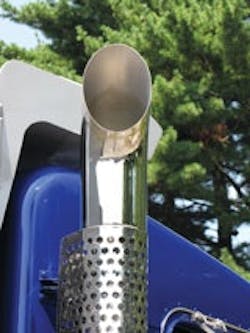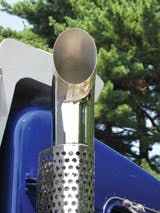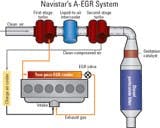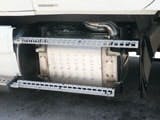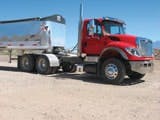SCR v. EGR: Which Way to Go?
The economy shows signs of improving, and your business should start perking up. Your present trucks will wear out and you'll have to somehow replace them, and chances are that sooner or later you'll buy a truck with a 2010 diesel. Its exhaust gases might be cleaner than the air it breathes in, and you'll be pleased that it will probably use less fuel than what you now run.
Right up front you'll pay thousands of dollars more for a 2010 diesel, just as you did for a 2007 model, if you have any of those. And the engine is likely to require more upkeep. If you now have some trucks with '07-legal diesels, you know that they make virtually no smoke, emit no odor and that, unless something went wrong in the engines, the inside of their exhaust pipes are free of the characteristic coating of soot that's a diesel tradition. Shouldn't that be enough for Clean Air authorities?
And why should there be only three years between implementation of the tough federal '07 limits and now the even tougher ones for '10? For that matter, the '07 rules came only three years after the '04 rules went into effect for all diesel builders; and most of the domestic manufacturers had to meet the '04 limits even sooner, in October '02, because they supposedly cheated in the designing of previous models.
What's the rush? It's because many experts argue that diesel emissions are fouling the air and injuring millions of people. The sooner exhaust gets cleaned up, the sooner our citizens will enjoy better health. Healthier people need less medical treatment, and in societal terms that will save more money than the cleaner engines will cost, according to health advocates. (If you live in California, you have the Air Resources Board's more draconian rules to contend with; see story on p. 26.)
Diesels in the United States were totally unregulated until 1989, and serious limits didn't come until 1994–95, when electronic controls were introduced. There are thousands of old, smoky diesels still out there, and environmentalists would love to pour some of that Clunker Cars' silicate solution into them.
In the late '90s, electronics were upgraded in an on-going process by engine makers, and oxidation catalysts were added to exhaust systems. October '02–January '04 limits required most builders to add exhaust-gas recirculation, which proved troublesome, along with advanced electronics, combustion design, higher-pressure fuel systems, and advanced turbocharging. Current '07 limits require all previous advances plus diesel particulate filters. Targets have been particulates, commonly called "soot"; nitrous oxides (NOx), which react with hydrocarbons to form atmospheric smog; and carbon monoxide and other ingredients which make diesel exhaust unhealthy.
The principal target for 2010 is NOx, which must come down from 1.2 gram per horsepower per hour to 0.2 gram — an 83 percent decrease. There are two ways of doing this: Using greater amounts of exhaust-gas recirculation, the method Navistar International has chosen; or injecting a urea fluid to break down NOx in the exhaust, which is called selective catalytic reduction and is the path chosen by all other engine builders. They are Cummins, Detroit Diesel, Paccar, and Volvo-Mack on the domestic side; and Hino, Isuzu, Mitsubishi Fuso, and Nissan UD among the imports. Light-truck diesels from Ford, General Motors and Dodge will also use SCR.
Many builders already use SCR in Europe and Japan, and it reportedly works well for emissions and appreciably increases fuel economy. SCR uses less fuel because the engine needn't be so finely tuned to cut NOx and can instead be set up for performance and economy. Also, fewer active "regenerations" of diesel particulate filters are needed to burn off soot, which in turn uses less fuel. Volvo here has begun advertising "no-regen" engines for 2010 because those in highway service will run hot enough to passively burn off soot. This might be less true of engines in stop-and-go service, as is the case with many construction trucks.
Cummins says SCR diesels use 3 to 6 percent less fuel than current engines, and there are reports of even greater savings. Dosing of SCR fluid is at the rate of 2 to 3 percent of fuel use. That fluid will cost some money, but unless it's seriously more than the price of diesel fuel, the truck user will still be money ahead compared to now. Navistar says the fuel economy of its engines will be about the same as now, but will cost less than competitors' engines up front. (Some will, some won't; see below.)
An SCR system requires the driver or maintenance staffer to replenish an on-board urea tank — a new chore. Owners must buy and store the fluid or have drivers find it while on the road. A pump pushes the fluid out of the tank; because fluid is about two-thirds purified water, a heater is used in the tank or line between it and the dosing chamber, where fluid is injected downstream of the particulate filter. This equipment plus the fluid, which weighs about 9 pounds per gallon, add 200 to 400 pounds and occupies sometimes precious space on a truck. This can be a major drawback to any weight-conscious owner and presents packaging problems to multi-axle dump trucks, among others.
Availability of urea fluid — also called diesel exhaust fluid, or DEF — was a worry to the federal EPA, which a few years ago balked at approving SCR for use here. But the industry convinced regulatory authorities that a distribution network would be in place by the time 2010 diesels hit the road. Indeed, fluid is already available in some places, so manufacturers and fleets testing '10-model diesels can obtain it. Eventually it'll be sold from bulk dispensers and in jugs. So the EPA has formally approved SCR as an emissions-reduction method.
Navistar considered SCR, but decided to go with what it calls Advanced EGR. This sends higher amounts of exhaust gases to cylinders, and uses enhanced electronic controls, even-higher-pressure fuel injection, multiple coolers, and double turbocharging. It can be argued that A-EGR is a more elegant approach than SCR because the NOx is handled totally in the cylinders. And it avoids the weight and bulk of SCR equipment, not to mention the chore of replenishing the fluid tanks. Thus A-EGR might be attractive to operators of construction trucks.
But Cummins is urging buyers to "think outside the cylinder." Its engineers and executives had planned to use both enhanced EGR and SCR for its 2010 models. Engines in over-the-road tractors would've used higher levels of EGR so operators wouldn't have to worry about finding urea fluid, while engines in local trucks would use SCR because operators could establish a ready source for the fluid.
Then Cummins executives saw that fluid distribution was going to be wide-spread, even out on the road, and meanwhile looked at results of its fuel economy testing and saw that SCR would yield better mileage, which most over-the-road customers demand. So more than a year ago Cummins did a partial about-face and announced that all its 2010 diesels for the United States and Canada would use SCR. This will cost Cummins much of its business with Navistar, which insists it will neither build nor install any SCR diesels in domestic trucks come January. Cummins might still supply non-SCR diesels for export of International trucks to countries whose laws are less stringent than here, but not for domestic use.
Navistar, meanwhile, continues to move toward total self-sufficiency in engines. For many years it has designed and built all of its medium-duty diesels, and it now also offers heavy-duty MaxxForce engines in 10.4- and 12.8-liter sizes. A recently struck deal with Caterpillar, which is leaving the domestic truck-engine business, will let Navistar base an upcoming 15-liter MaxxForce model on iron from Cat's C15.
Navistar dealers have been explaining A-EGR to customers and are emphasizing its advantages. Some might be attacking SCR, which is what Navistar executives have been doing aggressively since last year. They have charged that topping off urea tanks will be a burden to owners, drivers, and mechanics, who'll have to learn about the new SCR equipment and how to maintain it. Execs have said that urea fluid is toxic and dangerous to handle, that it will be hard to find, and that it will be expensive and therefore offset any fuel-economy advantage that SCR might have.
Most of those charges are false, say those in the SCR camp. Some builders have already begun to sell the fluid; they say its price will vary, but will probably mimic that of diesel fuel. As for toxicity, windshield-washer fluid is far more so, as is grease, motor oil, diesel fuel and gasoline, and even the general public safely handles these substances every day. Suppliers say that you can almost drink diesel exhaust fluid without injury, or spray it on your grass as a fertilizer (urea is the carrier for ammonia, DEF's active ingredient). If leached into soil, DEF chemically breaks down harmlessly.
Navistar predicts that fluid-based SCR will become an outmoded technology when better ways are found to reduce NOx. When this happens, trucks with SCR'd engines will become almost worthless. Navistar has tentative plans to generate ammonia right on the truck, so urea fluid and its tank won't be needed. Such systems are now being developed by Eaton and Integrated Fuel Technologies to do that, and Navistar hopes one or both will be ready by 2011.
Competitors say there are doubts either system will work in the real world, and even if they do, they'll add some weight and bulk to trucks — something that Navistar is now criticizing. Meanwhile, the SCR fluid distribution network — the so-called infrastructure — will be so convenient that users won't necessarily want to abandon it, and trucks will still be worth decent money.
SCR users have further reacted to Navistar's aggressive campaign by noting that they already employ EGR and know that it has limits. The EGR rate is controlled by electronics and a valve in the EGR piping; it varies from 0 to as much as 25 percent of inlet air under some conditions in '02–04 diesels. In '07 models it's as high as 35 to 40 percent; and in Navistar's A-EGR '10 engines it will top 50 percent at times. Competitors say such "massive" amounts of exhaust gas will subject engines to damaging heat, and the extra cooling needed to deal with more hot gas adds weight and bulk under the hood.
Navistar counters that any extra heat will be captured by additional coolers before the hot gases enter its engines, so they'll not be harmed. Most MaxxForce models will have two-pass EGR coolers, and those with double turbos will have a cooler between each, as some models already do. Bigger radiators were added to '07-model trucks and are sufficient to handle the heat from '10 engines, Navistar execs say. And a typical heavy International will weigh only about 50 pounds more than before. This is merely a greater use of a known technique, and the important thing is that customers won't have to learn about a new technology and cater to it, executives insist.
Navistar is also using legal challenges. It asked EPA to delay the 2010 rules to give truck buyers more time to adapt to the new emissions-reduction technologies, but EPA refused. Navistar also charged in a lawsuit that the EPA approved SCR without the public comment process it has used in previous rules writing. That gives users of SCR an unfair advantage. Competitors filed court briefs explaining their own positions and supporting EPA, much to Navistar's objections.
A spokesman for Volvo Trucks North America called Navistar's suit "a desperate act by a desperate company," intimating that Navistar knows A-EGR is inferior and is trying everything to thwart use of SCR. Navistar says it's suing for the sake of its customers, its stockholders and its employees. In July, the head of the company's engine program and a renowned German diesel expert, Dr. Helmet Endres, abruptly resigned, and neither he nor Navistar offered an explanation.
One more wrinkle is use of EPA "credits" to meet 2010 and earlier rules. Navistar and Cummins have both earned credits for producing and selling diesels that are cleaner than they had to be. Navistar has been making Green Diesel engines for more than nine years, and the Cummins Turbo Diesel used in Dodge's popular heavy pickups has been 2010-legal since 2007. Earned credits can be applied to other engines in a manufacturer's lineup.
Some current and future engine models technically put out slightly more than the stated limit for NOx, but they are legal according to EPA's rules, which allow as much as 0.5 gram per horsepower per hour of NOx in 2010 when combined with credits. Eventually those credits will run out, and the builders will have to meet the 0.2-gram limit; the builders say they know this, and are planning for it.
Customers should be aware that the emissions rules pertain to diesels, not trucks. At least one builder, Volvo, is now producing '10-model engines for a few customers who want to get acquainted with them early. But most diesels built through the end of December will be EPA-2007 models without A-EGR or SCR. Partly because of slow sales, most truck manufacturers will have EPA-'07 diesels on hand for several months into calendar 2010. Thus, many trucks built after Jan. 1 will get '07-model diesels. Chances are you can still order new trucks with '07-model engines, but you'd have to act soon.
All builders have been extensively testing their 2010 diesels, and some have units in the hands of fleet customers. Millions of miles of road testing will complement the lab work done as part of expensive development processes. Builders say the testing's intense pace has kept them from formally presenting the engines to trade-press writers for review. Mack showed an SCR engine in a Granite dump truck to CE more than a year ago, and Detroit Diesel recently offered drives in a highway tractor.
These drives show the engines make good power and torque, and express the builders' confidence in the products. Of course, they don't prove the systems' effectiveness at reducing emissions or show how well they'll hold up in everyday use. That's now being learned by testers and will show up later as customers put the new trucks into service.
Whether the A-EGR path or the SCR method works better in actual service is something that users, perhaps including you, will find out. If you're like many operators, you'll let large fleets with the resources to experiment try the new engines first, then make decisions based on what you hear from them. EPA-2007 diesels are already highly complex and require special care. Fleet managers have reported that the '07s are more reliable and less troublesome than the '02–04 engines. Maybe you're already buying some '07s to beat the 2010 versions and their higher prices, and if so, you're not alone from what we hear.
Clean air is increasingly expensive, as buyers of diesel-powered vehicles have been finding out for years. A 2007-model heavy diesel costs $7,000 to $10,000 more than a comparable pre-'07 engine, and 2010 models will still be pricier by about that amount. Cost and weight numbers for light- and medium-duty trucks with '10-legal diesels will be proportionally less than for heavies. Manufacturers who've announced price increases for 2010-model diesels are:
- Volvo Trucks — a $9,600 upcharge which itself will not be negotiable, the company declares. But of course the rest of the truck's list price will be, especially in a down economy. Mack, which like Volvo gets its engines from Volvo Powertrain, says its premium would be close to that of its sister company.
- Daimler Trucks — Freightliner and Western Star vehicles with heavy-duty Detroit Diesel engines will cost $9,000 more; Cummins ISC and ISB midrange engines will cost $7,300 and $6,700 more, respectively. Daimler will later announce pricing for the '10-model heavy Cummins ISX.
- Navistar — Heavy Internationals with 10-model MaxxForce diesels will cost an extra $8,000, and mediums will cost $6,000 more than now.
- General Motors — A '10-model Duramax diesel for Chevrolet and GMC light trucks might add $3,500 to $4,000 to the current diesel list-price premium of $7,000. An announcement will come later this fall.
- Dodge — The Cummins Turbo Diesel in 2500 and 3500 pickups uses an NOx adsorber that is already 2010-legal, so its price should not change much. But the diesel in cab-chassis models will have SCR hardware that will come at a higher price. It will be announced later.
Are there ways around the costlier 2010 diesels? Yes. But they'll cost money, too. - Keep the trucks you now have and spend money to keep them running.
- Check to see if you can still order new trucks with less costly 2007-spec diesels. If the salesman says yes, get it in writing with the right to cancel if a new truck comes though with the more expensive '10-spec diesel. Or take delivery, paint the exhaust stack eco-green — which you might do with clean-running '07 diesels, too — and brag that you're doing your civic duty to help clean the air.
- Buy glider-kitted trucks, which are brand new except for their engines, transmissions and sometimes axles. Those components can be installed used, rebuilt or remanufactured. Internal Revenue Service rules require that a completed glider kit sell for at least 25 percent less than the list price of a comparable new truck, and if so, it's exempt from the 12 percent federal excise tax. There are reports of local IRS agents overzealously trying to collect FET money on gliders, so be absolutely sure that any glider meets the rules and get documents to prove it.
Glider kits are available from Freightliner, Western Star and a few other truck builders. Assembling a glider requires knowledge and experience that your shop people probably don't have, so find a good supplier. Makers of front-discharge mixers — Indiana Phoenix, Oshkosh and Terex Advance — offer completed gliders done at their factories. - Retrofit the engines in existing trucks with pollution-reduction equipment if local or state laws require it. This is the case in California, New York City, and certain other places. Those in this business say '98 through '02 engines are good candidates for retrofitting, and older ones with electronic controls might also work. But pre-'95 diesels with mechanical controls cannot be effectively upgraded.
Special government grants are paying much of the retrofit expense, which ranges from $2,000 for an oxidation catalyst to $30,000 for a particulate filter. Federal Economic Stimulus money includes $300 million to boost such retrofits and other ways to embrace Clean Diesel methods, which include using Ultra Low Sulfur diesel fuel and buying '07 and '10 engines. Seek such grants because they can amount to big money. - Consider alternative fuels and electric power. Natural gas-powered engines are now available from Cummins and a partner, Westport Innovations, and some burn so cleanly that they are 2010-legal without particulate filters. Propane conversions of gasoline engines are available for light trucks, mostly Ford's F and E series. Both fuels are subsidized, so day-to-day operating costs should be less than for diesel fuel. Electric trucks are now for sale and some are entering service, but they are light- and medium-duty models that are meant for streets and not for rugged on/off-road service.
An alternative-fuel engine and fuel system adds about 50 percent and maybe more to the price of a truck or tractor, and fueling stations can be very costly. But federal tax credits and grants from various government entities can offset the upfront costs. More than $300 million in federal Economic Stimulus money is earmarked for alternative-fuel vehicles, and $2 billion for electric-vehicle and battery development. But the Stimulus money is already spoken for.
How about hybrid trucks? In urban service, electric and hydraulic hybrids can save 30 to 50 percent in fuel and cut exhaust emissions even more. With regenerative braking, hybrids can also greatly extend brake life. Some medium-duty hybrids are suitable for specialized construction-oriented tasks, and they are currently eligible for federal tax credits (which expire in December but are likely to be renewed). The hybrid credits are generally half those for alternative fuels, yet a hybrid's cost premium can approach that of an alternative fuel truck.
Hybrid trucks now available do not avoid 2010 or even 2007 diesel rules. That's because the hybrid drives are mated to diesel engines which need to be legal now and in the new year. If a hybrid with a natural-gas or propane engine were available, a buyer might be able to double-dip on grants and tax credits. We can scheme, can't we?
Some possibly good news is that federal emissions rules for 2010 are the last ones scheduled, so engine- and truck-builders and their customers should have a breather.
